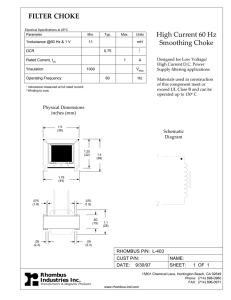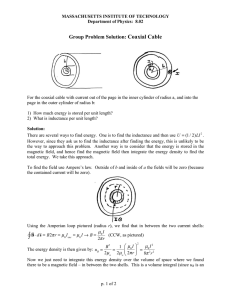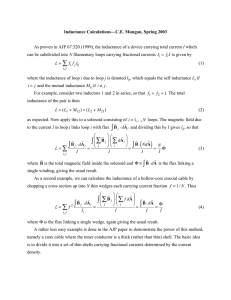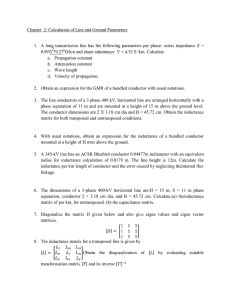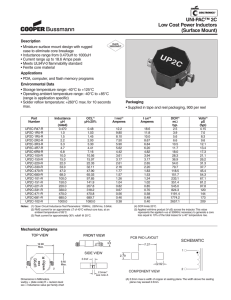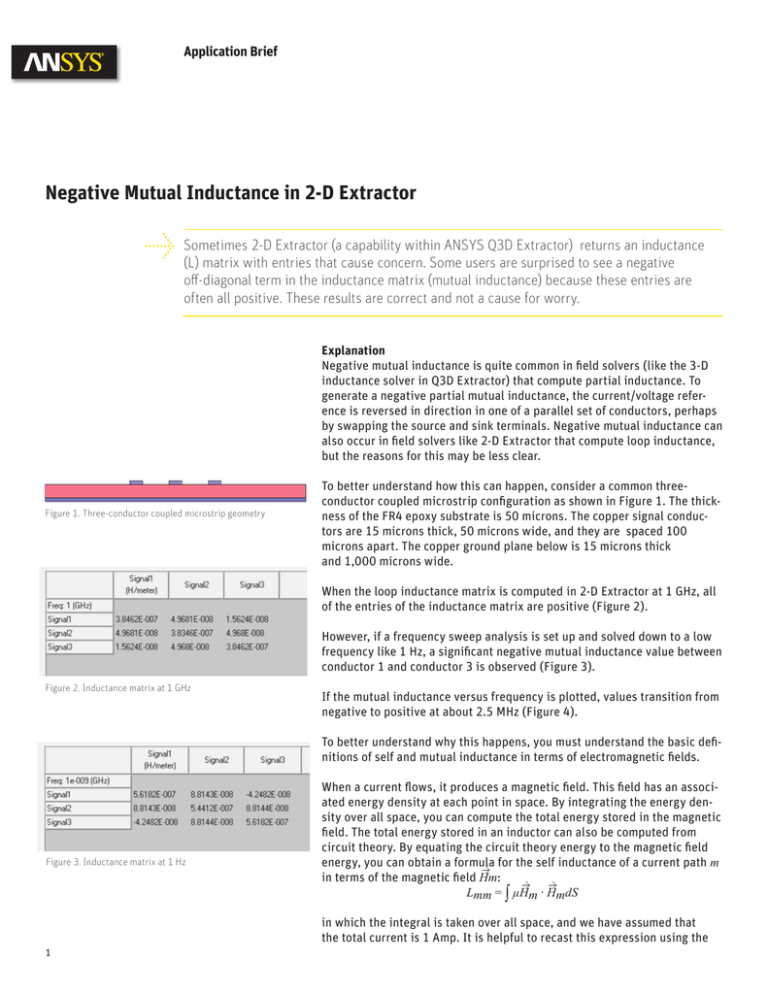
Application Brief
Negative Mutual Inductance in 2-D Extractor
Sometimes 2-D Extractor (a capability within ANSYS Q3D Extractor) returns an inductance
(L) matrix with entries that cause concern. Some users are surprised to see a negative
off-diagonal term in the inductance matrix (mutual inductance) because these entries are
often all positive. These results are correct and not a cause for worry.
Explanation
Negative mutual inductance is quite common in field solvers (like the 3-D
inductance solver in Q3D Extractor) that compute partial inductance. To
generate a negative partial mutual inductance, the current/voltage reference is reversed in direction in one of a parallel set of conductors, perhaps
by swapping the source and sink terminals. Negative mutual inductance can
also occur in field solvers like 2-D Extractor that compute loop inductance,
but the reasons for this may be less clear.
Figure 1. Three-conductor coupled microstrip geometry
To better understand how this can happen, consider a common threeconductor coupled microstrip configuration as shown in Figure 1. The thickness of the FR4 epoxy substrate is 50 microns. The copper signal conductors are 15 microns thick, 50 microns wide, and they are spaced 100
microns apart. The copper ground plane below is 15 microns thick
and 1,000 microns wide.
When the loop inductance matrix is computed in 2-D Extractor at 1 GHz, all
of the entries of the inductance matrix are positive (Figure 2).
However, if a frequency sweep analysis is set up and solved down to a low
frequency like 1 Hz, a significant negative mutual inductance value between
conductor 1 and conductor 3 is observed (Figure 3).
Figure 2. Inductance matrix at 1 GHz
If the mutual inductance versus frequency is plotted, values transition from
negative to positive at about 2.5 MHz (Figure 4).
To better understand why this happens, you must understand the basic definitions of self and mutual inductance in terms of electromagnetic fields.
Figure 3. Inductance matrix at 1 Hz
When a current flows, it produces a magnetic field. This field has an associated energy density at each point in space. By integrating the energy density over all space, you can compute the total energy stored in the magnetic
field. The total energy stored in an inductor can also be computed from
circuit theory. By equating the circuit theory energy to the magnetic field
energy, you can obtain a formula for the self inductance of a current path m
in terms of the magnetic field Hm:
Lmm = ∫ μHm ∙ HmdS
in which the integral is taken over all space, and we have assumed that
the total current is 1 Amp. It is helpful to recast this expression using the
1
Negative Mutual Inductance in 2D Extractor
vector potential Am and the current distribution Jm associated with the
magnetic field. It is possible to show that an equivalent formula for self
inductance is
Lmm= ∫ Am · Jm dS
The advantage of this expression is that the integrand is only non-zero in
conducting regions, because the current density Jm goes to zero elsewhere.
In fact, we need to look only at the conductors in the current path m of
interest (signal line and return) to evaluate it. So the integral becomes:
Figure 4. Plot of mutual inductance L13 versus frequency
Lmm = ∫S Am · Jm dS + ∫S Am · JmdS
m
g
Here Sm denotes the cross section of conductor m, and Sg denotes the cross
section of the ground return conductor. Note that the current density Jm
within the signal conductor will be positive, while the current density in
the ground conductor will be negative because it is flowing in the opposite
direction.
The expression for mutual inductance Lmn is similar to the above formula
for self inductance, with one modification:
Lmn =∫S Am · JndS +∫S Am · JndS
n
g
The integrand is now “mixed up” because it uses the vector potential from
current path m multiplied by the current density from path n. The current
density for signal path n is non-zero only over the cross section Sn of signal
conductor n (where it is positive) and the cross section of the ground return
conductor (where it is negative.)
Figure 5. Plot of vector potential at 1 GHz
This formula shows that for a mutual inductance to be positive, the integrand Am · Jn must be positive over most of the cross sectional area of the
signal and return conductors. If the sign of the current and the vector potential differ over a large part of these conducting regions, then the mutual
inductance will be negative.
A plot of the vector potential at 1 GHz is shown in Figure 5.
The field is concentrated in the region surrounding the active line (conductor 1) and drops off rapidly over distance. The physical reason for this is
that the current on the ground plane is bunching up beneath conductor 1 to
minimize the impedance of the loop, which is dominated by the loop’s self
inductance at high frequency.
Figure 6. Plot of vector potential at 1 Hz
The vector potential is positive everywhere and trends toward zero at the
ground plane. Therefore, regardless of the position of the conductors (and
their associated current), the first term in the mutual inductance equation
will be positive and the second term will be zero, resulting in a mutual
inductance that is positive overall.
When plotting the vector potential at 1 Hz, the plot looks quite different
(Figure 6). The magnetic fields now fully penetrate the conductors, and the
2
Negative Mutual Inductance in 2D Extractor
fields are non-zero over a much larger region. This more dispersed magnetic field is due to the ground plane. The ground plane is carrying the return
current for conductor 1. At low frequency, this current is free to spread out
uniformly over the entire ground plane to minimize the self resistance of
the current loop.
Figure 7. Plot of vector potential at 1 Hz using much wider (3,000
um) ground plane
The same plot illustrates that the vector potential becomes negative in
the region around conductor 3. As usual, the current density in the signal
conductor is positive, so this means that the first term of the mutual inductance equation will be negative for conductor 3. This is because the negative vector potential is the ground plane that is carrying a negative current
density and is closer to conductor 3 than is conductor 1, so the ground
plane has a greater influence over conductor 3 than the active signal line.
In the ground plane, the vector potential is generally non-zero and positive
(with a large magnitude) near the signal line and negative (with a small
magnitude) farther away. Because the current density in the ground plane
is uniform and negative, this means that the second integral in the mutual
inductance equation will be negative too, so negative mutual inductance
is observed.
Careful examination of the field lines in Figure 6 reveals that the vector
potential does not trend toward zero as distance from the excited signal
line increases, but it stays negative and actually increases slightly in
magnitude.
Figure 8. Mutual inductance L13 with 3,000 um ground plane
To determine what would happen to the mutual inductance if the ground
plane were larger — sufficient to change the sign of the ground plane integral and make the mutual inductance positive once again — the width of
the ground plane was increased from 1,000 microns to 3,000 microns and
resimulated. The resulting vector potential is plotted in Figure 7.
The region of negative vector potential is pushed much farther out from
the signal lines. The resulting mutual inductance is now positive for all
frequencies, as shown in Figure 8.
Clearly, the low-frequency mutual inductance between the lines is strongly
affected by the size of the ground plane used. To get some idea about how
important this effect is, a parametric sweep of the ground plane width
was performed in 2-D Extractor from widths of 1,000 microns to 3,000
microns in steps of 500 microns. Figure 9 shows the results for the mutual
inductance L13.
Figure 9. Mutual inductance L13 vs. frequency for different ground
plane widths
3
The plot shows that the mutual inductance is positive as long as the ground
plane width is about 1,500 microns or greater. Therefore, it appears from
this example that a reasonable guideline to follow to avoid negative mutual
inductances is to make the ground plane at least five times wider than
the maximum horizontal extent of the signal traces (350 microns in this
example.) You might be tempted to make it huge (perhaps 50 times wider
than the signal line extent), but this would waste computation time. The
low-frequency mutual inductance will always be a strong function of the
Negative Mutual Inductance in 2D Extractor
ground plane size, because the ground plane controls the extent of the
low-frequency current loop.
For frequencies of 10 MHz or higher, the ground plane size has little effect
on the result. This is expected, because at high frequencies the fields
concentrate strongly in the region surrounding the signal line to minimize
the inductive impedance.
Figure 10. Mutual inductance L12 vs. frequency for different
ground plane widths
The low-frequency mutual inductance L12 to the nearest neighbor line is
also affected by the width of the ground plane, as shown in Figure 10. The
variation is less than that for L13 but is still significant. Even the self inductance has a significant dependence on the ground plane width (again only
at low frequency), as shown in Figure 11.
However, an analysis of the fundamental electromagnetic definition for
mutual inductance shows that this is not a bug in the field solver but a
physically reasonable result. Negative mutual inductance is observed
only at low frequencies, and only when a relatively narrow ground return
conductor is present.
Figure 11. Self inductance L11 vs. frequency for different ground
plane widths
ANSYS, Inc.
Southpointe
275 Technology Drive
Canonsburg, PA 15317
U.S.A.
724.746.3304
ansysinfo@ansys.com
© 2013 ANSYS, Inc. All Rights Reserved.
ANSYS, Inc. is one of the world’s leading engineering simulation software providers. Its technology has enabled customers to predict with accuracy that their product designs will thrive in the real world. The company offers a common platform of
fully integrated multiphysics software tools designed to optimize product development processes for a wide range of industries, including aerospace, automotive,
civil engineering, consumer products, chemical process, electronics, environmental, healthcare, marine, power, sports and others. Applied to design concept,
final-stage testing, validation and trouble-shooting existing designs, software from
ANSYS can significantly speed design and development times, reduce costs, and
provide insight and understanding into product and process performance.
Visit www.ansys.com for more information.
Any and all ANSYS, Inc. brand, product, service and feature names, logos and slogans are registered trademarks or trademarks of ANSYS, Inc. or its subsidiaries in
the United States or other countries. All other brand, product, service and feature
names or trademarks are the property of their respective owners.


